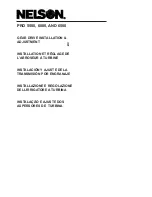
JUDO BIOSTAT 25 TGA
15
Operation
5.3.1 Treatment effect
The water treatment device works
completely automatically. The treatment
effect is adapted at the water flow. In the
feed to the water treatment device there is a
flow-meter.
The flow-meter consists of a propeller water
meter.
Due to the water flow the screw propeller,
that can be found in the propeller water
meter rotates, and a Hall Sensor receives
impulses from the magnet in the propeller.
The electronics then calculate the water flow
from the frequency and quantity of the
impulses. The electronics regulate the treat-
ment current referring to the relation that
exists between the applied voltage and the
treatment current as well as from the dura-
tion of the treatment current (impulse
length). The electronics optimise the treat-
ment current, according to the quality of the
water.
As soon as water flows, the water treatment
is indicated by the flashing of green LED 1
(see fig. 9).
5.3.2 Lime protection function
The water treatment device sets free the
minute seed crystals to which further lime
can attach itself. In the treatment section,
there is a titanium anode (positive pole) and
a circular stainless steel brush switched as
the cathode (negative pole). As soon as
water flows, there is a pulsating direct current
applied to these two electrodes so that there
is a flow of electricity between the elec-
trodes. Dissolved calcium in the form of
calcium carbonate crystals is then deposited
on the cathode (the circular stainless steel
brushes). On cleaning, these crystals of
calcium carbonate are thrown off the sepa-
rate bristles by rotating the circular brush.
The crystals thus formed are minute micro-
crystals. Larger crystals which may possibly
also appear sink together with separate
loose brush particles to the bottom and are
flushed out via the flushing valve during
cleaning.
The lime particles can be seen in the
flushing water as very fine “sand”. The
microcrystals remain in suspension and
thus form seed crystals on which further lime
can be deposited. Principally in the warm
water field the growth of the crystals can be
realized by a gradual clouding of the water.
The crystals slowly grow large enough to be
able to disperse the rays of light. At that
stage, they are but a few thousandths of a
millimeter in size. But even these crystals
are small enough to remain in suspension
and to be flushed out with the water flow.
The same process goes on in the cold water
field, too, although the potential here for
deposition of lime is considerably less in
normal circumstances. Since the excess
lime (calcium) is now deposited at the seed
crystals, other surfaces (e. g. pipework,
boiler etc.) are not affected by lime deposits
so that heating elements for example no
longer fur up. Although this formation of
crystals does reduce the hardness of the
water, the reduction is so small that they
remain undetectable by means of simple
measuring instruments.














































